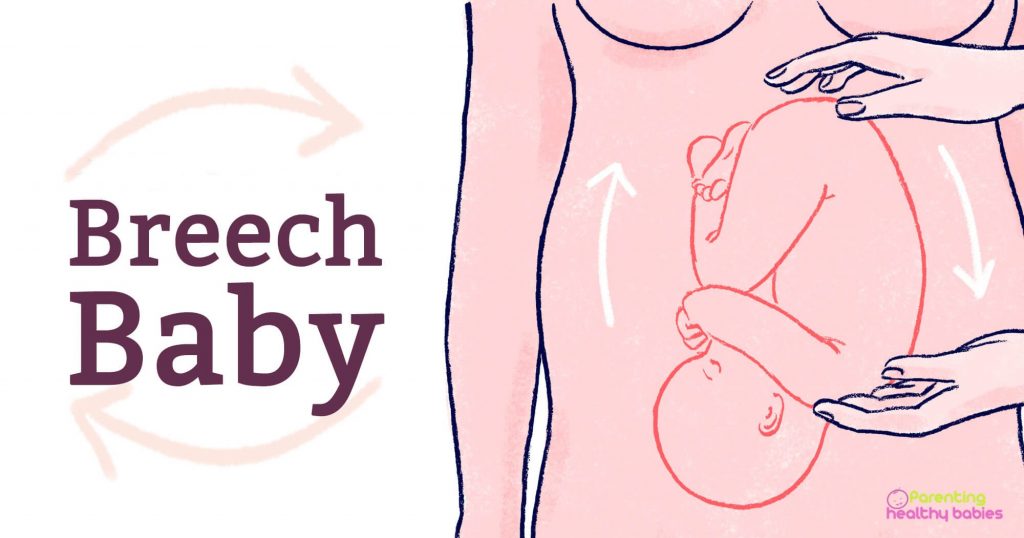Babies are born upside down. It is a known fact. But did you know that 1 in 25 babies born are bottom first? Next time when you are joking, ask your friends if they were born the ‘wrong’ way, it just might be true.
Everything You Need to Know about Breech Baby
WHAT ARE BREECH BABIES?
Breech baby is the delivery of a fetus in feet first or bottom first position instead of the normal head first position. About 3-4% of all pregnancies result in a breech baby. This is a potentially dangerous situation.
On the basis of movements of fetus, pregnancy can be divided into three phases:
- Till 24th week: the fetus moves around freely in the womb. Its position is ever changing.
- 25th to 35th week: the fetus finds its position. Changing of position is common.
- After 36 week: the position of baby becomes fixed. It seldom changes its position. A breech baby is identified at this point in the pregnancy.
Read more: Third Trimester: Pregnancy Week by Week
TYPES OF BREECH POSITIONS
Breech positions can broadly be categorized into 3 categories
- Frank breech or extended breech: This is the most common breech position. The legs of the fetus are up next to its abdomen, knee straight and feet next to ears.
- Complete breech: The baby appears to be sitting cross legged with legs bent at hips and knees.
- Footling breech: In this position one or both feet are born first. This is the most common type of breech in preterm births.
CAUSES OF BREECH BABY
- Pregnancies of multiples (i.e. having twins/triplets etc.)
- Premature delivery
- Too much or too little amniotic fluid
- Growth of mass in uterus like fibroids
- Placenta previa i.e. position of placenta near or over the opening of uterus.
- Short length of umbilical cord
- Abnormally shaped uterus
DELIVERING A BREECH BABY
Cesarean section is the preferred mode of delivery in the case of a breech baby as it causes lesser mortality and competitions for the baby than a normal vaginal birth. However, risks to the mother are the same in both the methods.
IS VAGINAL DELIVERY POSSIBLE
Vaginal delivery, though avoided can be done in cases where risk is minimal. The favorable factors are –
- Full term baby
- Frank presentation
- Normal fetal heart rate
- If process of labor is smooth with cervix widening as the baby descends.
- Baby is not too big or the pelvis too narrow for normal delivery to occur.
COMPLICATIONS OF VAGINAL DELIVERY
- A birth defect may occur in which the hip socket and the thigh bone of the baby separate from each other.
- Umbilical cord prolapse: Sometimes, in a breech baby, umbilical cord or a part of it may protrude before the baby comes out. This may compress the umbilical cord and cause the death of the fetus.
- Oxygen deprivation: this may occur due to rupture of placenta or the compression of umbilical cord. This may cause mental retardation and stunted mental development.
- Injury to brain and skull: Unlike the slow acclimatization of the head to the external environment in a ‘normal’ cephalic delivery, in a breech delivery, the brain and the skull decompress rapidly. This may cause brain and spinal cord injury which are debilitating later in life
- Head entrapment: in pre-term deliveries, the width of the head of the baby is greater than the width of the pelvis. This may cause entrapment of the head which may lead to neurological defects.
- Researchers have identified a relationship between breech birth and autism.
WHAT CAN YOU DO?
- Visit your doctor regularly during your pregnancy for checkups.
- Take proper nutrition during your pregnancy. Include iron, folic acid and B 12 in your diet.
- Plan the delivery. Studies suggest that a planned delivery with help of an experienced assistant (doctor or midwife) reduces the risk of complications up to 35%.
- Follow the exercise schedule recommended by your doctor.
- Consult your doctor before undertaking any procedure that helps turn the baby.
TECHNIQUES TO TURN THE BABY
External version: This is a medically prescribed technique done at the end of the pregnancy in the 37th If the doctor finds a breech presentation during 32nd to 37th week, they may suggest external version if:
- There is no vaginal bleeding
- Normal position of placenta is present i.e. there is no placenta near or covering the opening of uterus.
- Quantity of amniotic fluid is normal.
- Fetus does not show any signs of distress and fetal heart rate and sounds are normal.
- Twins or triplets are not present.
- There is no sign of premature rupture of membrane.
Procedure:
- The doctor will palpate the abdomen to find the head of the fetus. Ultrasonography may be done to confirm the position.
- She/he will then place you in a comfortable position and use hands to turn the baby.
Success rates of external version are only 58%. It is possible for the fetus to revert back to breech position after external version. In such a case, the process of external version may be repeated.
The success rates depend on the weight and position of the baby, the position of the placenta, amount of amniotic fluid to protect the baby and due date.
Risks:
- External version is generally safe for both the mother and the baby but a few risks involved are:
- Sudden onset of labor during which the baby may be delivered through cesarean section.
- A small amount of blood loss for both child and the mother.
- Premature rupture of membrane and fetal distress which may lead to emergency delivery of the baby.
- Webster-Breech technique: This is a chiropractic technique developed by late chiropractor DR. Webster. It aims at reducing the stress on the pregnant pelvis by causing relaxation of the uterus and ligaments. It is done in the 8th There is some evidence to suggest that the baby may turn naturally during the procedure.
- Breech tilt: This technique has long been practiced to turn the baby. Large pillows are used to raise hips 30cm off the ground for 10-15 minutes three times a day. It is best to do this on empty stomach. It is recommended to consult your doctor before practicing this technique.
- Essential oils like peppermint may be used to relax the mother and help in turning the baby naturally
- Moxibustion: Moxibustion is a Chinese herbal treatment in which mugwort along with other dried herbs called ‘moxa’ are burned near the skin followed by acupuncture of pinky toes.
Always consult your doctor before following any technique.
Stay informed, Stay safe.
Hope this article was of help for all our parents!! Please share your comments/queries/tips with us and help us create a world full of Happy and Healthy Babies!!















